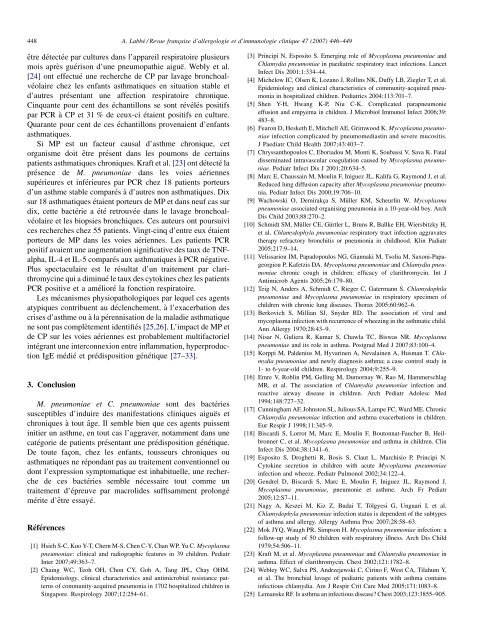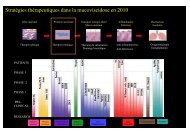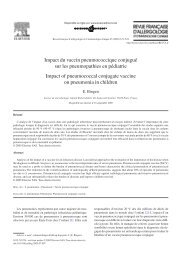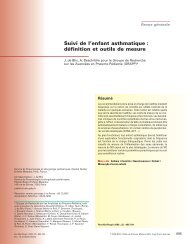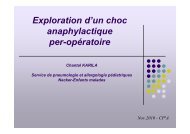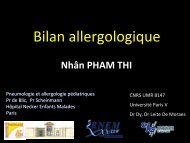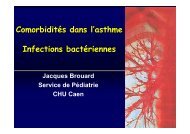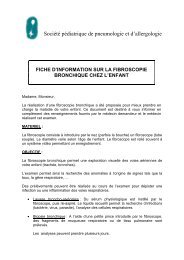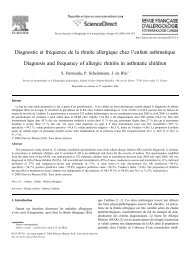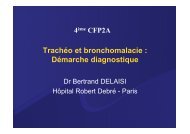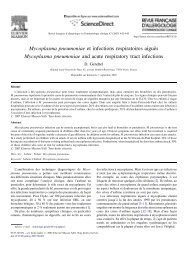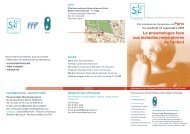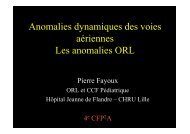Séquelles respiratoires des infections à "Mycoplasma pneumoniae"
Séquelles respiratoires des infections à "Mycoplasma pneumoniae"
Séquelles respiratoires des infections à "Mycoplasma pneumoniae"
You also want an ePaper? Increase the reach of your titles
YUMPU automatically turns print PDFs into web optimized ePapers that Google loves.
448<br />
A. Labbé / Revue française d’allergologie et d’immunologie clinique 47 (2007) 446–449<br />
être détectée par cultures dans l’appareil respiratoire plusieurs<br />
mois après guérison d’une pneumopathie aiguë. Webly et al.<br />
[24] ont effectué une recherche de CP par lavage bronchoalvéolaire<br />
chez les enfants asthmatiques en situation stable et<br />
d’autres présentant une affection respiratoire chronique.<br />
Cinquante pour cent <strong>des</strong> échantillons se sont révélés positifs<br />
par PCR à CP et 31 % de ceux-ci étaient positifs en culture.<br />
Quarante pour cent de ces échantillons provenaient d’enfants<br />
asthmatiques.<br />
Si MP est un facteur causal d’asthme chronique, cet<br />
organisme doit être présent dans les poumons de certains<br />
patients asthmatiques chroniques. Kraft et al. [23] ont détecté la<br />
présence de M. pneumoniae dans les voies aériennes<br />
supérieures et inférieures par PCR chez 18 patients porteurs<br />
d’un asthme stable comparés àd’autres non asthmatiques. Dix<br />
sur 18 asthmatiques étaient porteurs de MP et dans neuf cas sur<br />
dix, cette bactérie a été retrouvée dans le lavage bronchoalvéolaire<br />
et les biopsies bronchiques. Ces auteurs ont poursuivi<br />
ces recherches chez 55 patients. Vingt-cinq d’entre eux étaient<br />
porteurs de MP dans les voies aériennes. Les patients PCR<br />
positif avaient une augmentation significative <strong>des</strong> taux de TNFalpha,<br />
IL-4 et IL-5 comparés aux asthmatiques à PCR négative.<br />
Plus spectaculaire est le résultat d’un traitement par clarithromycine<br />
qui a diminué le taux <strong>des</strong> cytokines chez les patients<br />
PCR positive et a amélioré la fonction respiratoire.<br />
Les mécanismes physiopathologiques par lequel ces agents<br />
atypiques contribuent au déclenchement, à l’exacerbation <strong>des</strong><br />
crises d’asthme ou à la pérennisation de la maladie asthmatique<br />
ne sont pas complètement identifiés [25,26]. L’impact de MP et<br />
de CP sur les voies aériennes est probablement multifactoriel<br />
intégrant une interconnexion entre inflammation, hyperproduction<br />
IgE médié et prédisposition génétique [27–33].<br />
3. Conclusion<br />
M. pneumoniae et C. pneumoniae sont <strong>des</strong> bactéries<br />
susceptibles d’induire <strong>des</strong> manifestations cliniques aiguës et<br />
chroniques à tout âge. Il semble bien que ces agents puissent<br />
initier un asthme, en tout cas l’aggraver, notamment dans une<br />
catégorie de patients présentant une prédisposition génétique.<br />
De toute façon, chez les enfants, tousseurs chroniques ou<br />
asthmatiques ne répondant pas au traitement conventionnel ou<br />
dont l’expression symptomatique est inhabituelle, une recherche<br />
de ces bactéries semble nécessaire tout comme un<br />
traitement d’épreuve par macroli<strong>des</strong> suffisamment prolongé<br />
mérite d’être essayé.<br />
Références<br />
[1] Hsieh S-C, Kuo Y-T, Chern M-S, Chen C-Y, Chan WP, Yu C. <strong>Mycoplasma</strong><br />
pneumoniae: clinical and radiographic features in 39 children. Pediatr<br />
Inter 2007;49:363–7.<br />
[2] Chaing WC, Teoh OH, Chon CY, Goh A, Tang JPL, Chay OHM.<br />
Epidemiology, clinical characteristics and antimicrobial resistance patterns<br />
of community-acquired pneumonia in 1702 hospitalized children in<br />
Singapore. Respirology 2007;12:254–61.<br />
[3] Principi N, Esposito S. Emerging role of <strong>Mycoplasma</strong> pneumoniae and<br />
Chlamydia pneumoniae in paediatric respiratory tract <strong>infections</strong>. Lancet<br />
Infect Dis 2001;1:334–44.<br />
[4] Michelow IC, Olsen K, Lozano J, Rollins NK, Duffy LB, Ziegler T, et al.<br />
Epidemiology and clinical characteristics of community-acquired pneumonia<br />
in hospitalized children. Pediatrics 2004;113:701–7.<br />
[5] Shen Y-H, Hwang K-P, Niu C-K. Complicated parapneumonie<br />
effusion and empyema in children. J Microbiol Immunol Infect 2006;39:<br />
483–8.<br />
[6] Fearon D, Hesketh E, Mitchell AE, Grimwood K. <strong>Mycoplasma</strong> pneumoniae<br />
infection complicated by pneumomediastin and severe mucositis.<br />
J Paediatr Child Health 2007;43:403–7.<br />
[7] Chryssanthopoulos C, Eboriadou M, Monti K, Soubassi V, Sava K. Fatal<br />
disseminated intravascular coagulation caused by <strong>Mycoplasma</strong> pneumoniae.<br />
Pediatr Infect Dis J 2001;20:634–5.<br />
[8] Marc E, Chaussain M, Moulin F, Iniguez JL, Kalifa G, Raymond J, et al.<br />
Reduced lung diffusion capacity after <strong>Mycoplasma</strong> pneumoniae pneumonia.<br />
Pediatr Infect Dis 2000;19:706–10.<br />
[9] Wachowski O, Demirakça S, Müller KM, Scheurlin W. <strong>Mycoplasma</strong><br />
pneumoniae associated organising pneumonia in a 10-year-old boy. Arch<br />
Dis Child 2003;88:270–2.<br />
[10] Schmidt SM, Müller CE, Gürtler L, Bruns R, Ballke EH, Wiersbitzky H,<br />
et al. Chlamydophyla pneumoniae respiratory tract infection aggravates<br />
therapy refractory bronchitis or pneumonia in childhood. Klin Padiatr<br />
2005;217:9–14.<br />
[11] Velissariou IM, Papadopoulos NG, Giannaki M, Tsolia M, Saxoni-Papageorgiou<br />
P, Kafetzis DA. <strong>Mycoplasma</strong> pneumoniae and Chlamydia pneumoniae<br />
chronic cough in children: efficacy of clarithromycin. Int J<br />
Antimicrob Agents 2005;26:179–80.<br />
[12] Teig N, Anders A, Schmidt C, Rieger C, Gatermann S. Chlamydophila<br />
pneumoniae and <strong>Mycoplasma</strong> pneumoniae in respiratory specimen of<br />
children with chronic lung diseases. Thorax 2005;60:962–6.<br />
[13] Berkovich S, Millian SJ, Snyder RD. The association of viral and<br />
mycoplasma infection with recurrence of wheezing in the asthmatic child.<br />
Ann Allergy 1970;28:43–9.<br />
[14] Nisar N, Guliera R, Kumar S, Chawla TC, Biswas NR. <strong>Mycoplasma</strong><br />
pneumoniae and its role in asthma. Postgrad Med J 2007;83:100–4.<br />
[15] Korppi M, Paldenius M, Hyvarinen A, Nevalainen A, Husman T. Chlamydia<br />
pneumoniae and newly diagnosis asthma; a case control study in<br />
1- to 6-year-old children. Respirology 2004;9:255–9.<br />
[16] Emre V, Roblin PM, Gelling M, Dumornay W, Rao M, Hammerschlag<br />
MR, et al. The association of Chlamydia pneumoniae infection and<br />
reactive airway disease in children. Arch Pediatr Adolesc Med<br />
1994;148:727–32.<br />
[17] Cunningham AF, Johnston SL, Julious SA, Lampe FC, Ward ME. Chronic<br />
Chlamydia pneumoniae infection and asthma exacerbations in children.<br />
Eur Respir J 1998;11:345–9.<br />
[18] Biscardi S, Lorrot M, Marc E, Moulin F, Boutonnat-Faucher B, Heilbronner<br />
C, et al. <strong>Mycoplasma</strong> pneumoniae and asthma in children. Clin<br />
Infect Dis 2004;38:1341–6.<br />
[19] Esposito S, Droghetti R, Bosis S, Claut L, Marchisio P, Principi N.<br />
Cytokine secretion in children with acute <strong>Mycoplasma</strong> pneumoniae<br />
infection and wheeze. Pediatr Pulmonol 2002;34:122–4.<br />
[20] Gendrel D, Biscardi S, Marc E, Moulin F, Iniguez JL, Raymond J.<br />
<strong>Mycoplasma</strong> pneumoniae, pneumonie et asthme. Arch Fr Pediatr<br />
2005;12:S7–11.<br />
[21] Nagy A, Keszei M, Kiz Z, Budai T, Tölgyesi G, Unguari I, et al.<br />
Chlamydophyla pneumoniae infection status is dependent of the subtypes<br />
of asthma and allergy. Allergy Asthma Proc 2007;28:58–63.<br />
[22] Mok JYQ, Waugh PR, Simpson H. <strong>Mycoplasma</strong> pneumoniae infection: a<br />
follow-up study of 50 children with respiratory illness. Arch Dis Child<br />
1979;54:506–11.<br />
[23] Kraft M, et al. <strong>Mycoplasma</strong> pneumoniae and Chlamydia pneumoniae in<br />
asthma. Effect of clarithromycin. Chest 2002;121:1782–8.<br />
[24] Webley WC, Salva PS, Andrzejewski C, Cirino F, West CA, Tilahum Y,<br />
et al. The bronchial lavage of pediatric patients with asthma contains<br />
infectious chlamydia. Am J Respir Crit Care Med 2005;171:1083–8.<br />
[25] Lemanske RF. Is asthma an infectious disease? Chest 2003;123:3855–905.


